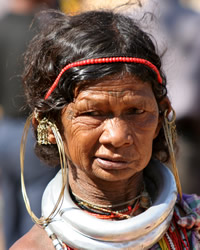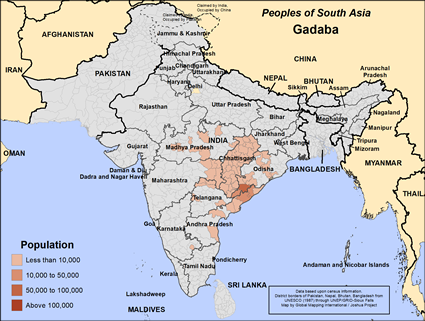Gadaba in India

Photo Source:
PICQ - Wikimedia
Creative Commons
|

Map Source:
People Group data: Omid. Map geography: UNESCO / GMI. Map Design: Joshua Project
|
| People Name: | Gadaba |
| Country: | India |
| 10/40 Window: | Yes |
| Population: | 138,000 |
| World Population: | 138,000 |
| Primary Language: | Telugu |
| Primary Religion: | Hinduism |
| Christian Adherents: | 1.64 % |
| Evangelicals: | 0.82 % |
| Scripture: | Complete Bible |
| Ministry Resources: | Yes |
| Jesus Film: | Yes |
| Audio Recordings: | Yes |
| People Cluster: | South Asia Tribal - other |
| Affinity Bloc: | South Asian Peoples |
| Progress Level: |
|
Introduction / History
The Munda-Santal tribes of northeastern India and Nepal are comprised of nine different, but very closely related people groups. The seven groups who occupy territory farther north include the Santal (of India and Nepal), the Bhumij, the Koda, the Mahili, the Ho, and the Agariya. The two remaining groups, the Juang and the Gadaba, are located to the south, nearer to the coast of the Bay of Bengal. What can be said of the Gadaba people can probably also be said about the others. Tribal culture among the Gadaba is quickly changing under the impact of external influences such as industrialization, new communication links, government directed tribal welfare schemes, and community development projects. Traditions regarding the origin of the Munda-Santal tribes are uncertain; but originally, the forested area of Chotanagpur was ruled by chiefs of various tribes. Gradually, the British established their authority.
What Are Their Lives Like?
Today, the government is trying to preserve forests, so cultivation shifting is limited. There is also an increase in the amount of irrigated land. As a result, they are developing other sources of income. They include such jobs as working in the tea plantations of the northeast, working in the steel industry, or working as day laborers for local Hindu landowners. Since the Chotanagpur Plateau is the richest mineral belt in India, some earn wages by mining. Both men and women work to bring home adequate income for their families. Although very few of the tribes live by trade, some have traditional artisan or specialist occupations. Two such groups are the Koda, who are ditch diggers, and the Gadaba, who are known for their wall-paintings. The Gadaba are also noted for the dyed clothes worn by the women. They wear red, white and blue striped garments, dyed with natural materials. The weekly market plays an important part in the economy of these tribes. Most of the people live in clustered villages or villages with one street. Like other tribes in the Munda-Santal cluster, the Gadaba are divided into clans which recognize a common ancestor. Clan members often marry those from other tribes; however, there are smaller sub-tribes who are permitted to marry only those within their group. There is also a bachelor's dormitory.
What Are Their Beliefs?
Like other Munda-Santal tribes, the Gadaba tend to preserve their own beliefs, values, and separate identity. Most are Hindus who also practice ethnic religions. Their supreme god is the sun god. However, they have also adopted the Hindu deities in addition to tribal gods and goddesses. The Hindu village priest is the ritual specialist, and they observe many Hindu festivals. They do have a firm belief in an almighty creator and also in "mother earth. "
What Are Their Needs?
When the gospel is preached, the Gadaba listen and often respond. There is a need for workers to go to them and the other Munda-Santal tribes.
Prayer Points
Pray that God will send culturally sensitive workers who will show the Gadaba people the way to the cross. Pray for a flourishing movement to Christ among them starting in the 2020s. Pray for the Gadaba people to be blessed with peace, joy and spiritual prosperity as they follow Jesus Christ.